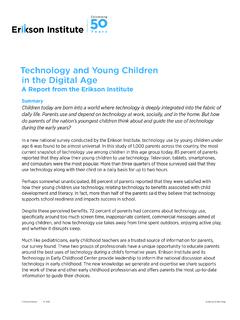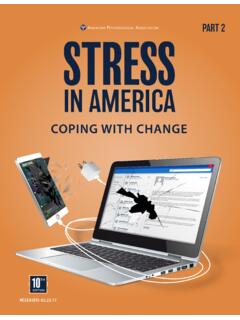Transcription of Teens, Social Media & Technology 2018 | Pew Research …
1 teens , Social Media & Technology 2018 YouTube, Instagram and Snapchat are the mostpopular online platforms among teens . Fully 95% ofteens have access to a smartphone, and 45% say theyare online 'almost constantly'By Monica Anderson and Jingjing Jiang(Drew Angerer/Getty Images News via Getty Images)Until recently, Facebook had dominated the Social Media landscape amongAmerica s youth but it is no longer the most popular online platform amongteens, according to a new Pew Research Center survey . Today, roughly half(51%) of teens ages 13 to 17 say they use Facebook, notably lower thanthe shares who use YouTube, Instagram or shift in teens Social Media use is just one example of how the technologylandscape for young people has evolved since the Center s last survey of teensand Technology use in 2014-2015. Most notably, smartphone ownership hasbecome a nearly ubiquitous element of teen life: 95% of teens now report theyhave a smartphone or access to one. These mobile connections are in turnfueling more-persistent online activities: 45% of teens now say they are onlineon a near-constant survey also finds there is no clear consensus among teens about the effectthat Social Media has on the lives of young people today.
2 Minorities of teensdescribe that effect as mostly positive (31%) or mostly negative (24%), but thelargest share (45%) says that effect has been neither positive nor are some of the main findings from the Center s survey of teensconducted March 7-April 10, 2018 . Throughout the report, teens refers tothose ages 13 to is no longer the dominant online platform among teensThe Social Media landscape in which teens reside looks markedly differentthan it did as recently as three years ago. In the Center s 2014-2015 survey ofteen Social Media use, 71% of teens reported being Facebook users. No otherplatform was used by a clear majority of teens at the time: Around half (52%)of teens said they used Instagram, while 41% reported using 2018 , three online platforms other than Facebook YouTube, Instagramand Snapchat are used by sizable majorities of this age group. Meanwhile,51% of teens now say they use Facebook. The shares of teens who use Twitterand Tumblr are largely comparable to the shares who did so in the the most part, teens tend to usesimilar platforms regardless of theirdemographic characteristics, butthere are exceptions.
3 Notably, lower-income teens are more likely togravitate toward Facebook than thosefrom higher-income households atrend consistent with previous Centersurveys. Seven-in-ten teens living inhouseholds earning less than$30,000 a year say they useFacebook, compared with 36% whoseannual family income is $75,000 or more. (For details on Social mediaplatform use by different demographic groups, see Appendix A.)It is important to note there were some changes in question wording betweenPew Research Center s 2014-2015 and 2018 surveys of teen Social Media and Reddit were not included as options in the 2014-2015 surveybut were included in the current survey . In addition, the 2014-2015 surveyrequired respondents to provide an explicit response for whether or not theyused each platform, while the 2018 survey presented respondents with a listof sites and allowed them to select the ones they Even so, it is clear thesocial Media environment today revolves less around a single platform than itdid three years it comes to which one of these online platforms teens use the most,roughly one-third say they visit Snapchat (35%) or YouTube (32%) mostoften, while 15% say the same of Instagram.
4 By comparison, 10% of teens sayFacebook is their most-used online platform, and even fewer cite Twitter,Reddit or Tumblr as the site they visit most , lower-income teens are far more likely than those from higher incomehouseholds to say Facebook is the online platform they use most often (22%vs. 4%). There are also some differences related to gender and to race andethnicity when it comes to teens most-used sites. Girls are more likely thanboys to say Snapchat is the site they use most often (42% vs. 29%), while boysare more inclined than girls to identify YouTube as their go-to platform (39%vs. 25%). Additionally, white teens (41%) are more likely than Hispanic (29%)or black (23%) teens to say Snapchat is the online platform they use mostoften, while black teens are more likely than whites to identify Facebook astheir most used site (26% vs. 7%). teens have mixed views on the impact of Social Media on theirlivesDespite the nearly ubiquitous presence of Social Media in their lives, there isno clear consensus among teens about these platforms ultimate impact onpeople their age.
5 A plurality of teens (45%) believe Social Media has a neitherpositive nor negative effect on people their age. Meanwhile, roughly three-in-ten teens (31%) say Social Media has had a mostly positive impact, while 24%describe its effect as mostly the opportunity to explain their views in their own words, teens whosay Social Media has had a mostly positive effect tended to stress issuesrelated to connectivity and connection with others. Some 40% of theserespondents said that Social Media has had a positive impact because it helpsthem keep in touch and interact with others. Many of these responsesemphasize how Social Media has made it easier to communicate with familyand friends and to connect with new people: I think Social Media have a positive effect because it lets you talk to familymembers far away. (Girl, age 14) I feel that Social Media can make people my age feel less lonely or alone. Itcreates a space where you can interact with people. (Girl, age 15) It enables people to connect with friends easily and be able to make newfriends as well.
6 (Boy, age 15)Others in this group cite the greater access to news and information thatsocial Media facilitates (16%), or being able to connect with people who sharesimilar interests (15%): My mom had to get a ride to the library to get what I have in my hand allthe time. She reminds me of that a lot. (Girl, age 14) It has given many kids my age an outlet to express their opinions andemotions, and connect with people who feel the same way. (Girl, age 15)Smaller shares argue that Social Media is a good venue for entertainment(9%), that it offers a space for self-expression (7%) or that it allows teens toget support from others (5%) or to learn new things in general (4%). Because a lot of things created or made can spread joy. (Boy, age 17) [ Social Media ] allows us to communicate freely and see what everyone elseis doing. [It] gives us a voice that can reach many people. (Boy, age 15) We can connect easier with people from different places and we are morelikely to ask for help through Social Media which can save people.
7 (Girl, age15)There is slightly less consensus among teens who say Social Media has had amostly negative effect on people their age. The top response (mentioned by27% of these teens ) is that Social Media has led to more bullying and theoverall spread of rumors. Gives people a bigger audience to speak and teach hate and belittle eachother. (Boy, age 13) People can say whatever they want with anonymity and I think that has anegative impact. (Boy, age 15) Because teens are killing people all because of the things they see on socialmedia or because of the things that happened on Social Media . (Girl, age 14)Meanwhile, 17% of these respondents feel these platforms harm relationshipsand result in less meaningful human interactions. Similar shares think socialmedia distorts reality and gives teens an unrealistic view of other people slives (15%), or that teens spend too much time on Social Media (14%). It has a negative impact on Social (in-person) interactions. (Boy, age 17) It makes it harder for people to socialize in real life, because they becomeaccustomed to not interacting with people in person.
8 (Girl, age 15) It provides a fake image of someone s life. It sometimes makes me feel thattheir life is perfect when it is not. (Girl, age 15) [ teens ] would rather go scrolling on their phones instead of doing theirhomework, and it s so easy to do so. It s just a huge distraction. (Boy, age17)Another 12% criticize Social Media for influencing teens to give in to peerpressure, while smaller shares express concerns that these sites could lead topsychological issues or majority of teens have access to a home computer orsmartphoneSome 95% of teens now say they have or have access to a smartphone, whichrepresents a 22-percentage-point increase from the 73% of teens who saidthis in 2014-2015. Smartphone ownership is nearly universal among teens ofdifferent genders, races and ethnicities and socioeconomic more nuanced story emerges when it comes to teens access to 88% of teens report having access to a desktop or laptop computer athome, access varies greatly by income level.
9 Fully 96% of teens fromhouseholds with an annual income of $75,000 or more per year say they haveaccess to a computer at home, but that share falls to 75% among those fromhouseholds earning less than $30,000 a access also varies by the level of education among parents. Teenswho have a parent with a bachelor s degree or more are more likely to saythey have access to a computer than teens whose parents have a high schooldiploma or less (94% vs. 78%).A growing share of teens describe their internet use as near-constantAs smartphone access has becomemore prevalent, a growing share ofteens now report using the internet ona near-constant basis. Some 45% ofteens say they use the internet almost constantly, a figure that hasnearly doubled from the 24% whosaid this in the 2014-2015 44% say they go onlineseveral times a day, meaning roughlynine-in-ten teens go online at leastmultiple times per are some differences in teens frequency of internet use by gender, aswell as race and ethnicity.
10 Half of teenage girls (50%) are near-constantonline users, compared with 39% of teenage boys. And Hispanic teens aremore likely than whites to report using the internet almost constantly (54%vs. 41%).A majority of both boys and girls play video games, but gaming isnearly universal for boysOverall, 84% of teens say they have or have accessto a game console at home, and 90% say they playvideo games of any kind (whether on a computer,game console or cellphone). While a substantialmajority of girls report having access to a gameconsole at home (75%) or playing video games ingeneral (83%), those shares are even higheramong boys. Roughly nine-in-ten boys (92%) haveor have access to a game console at home, and97% say they play video games in some form has been growth in game console ownership among Hispanic teens andteens from lower-income families since the Center s previous study of theteen Technology landscape in 2014-2015. The share of Hispanics who say theyhave access to a game console at home grew by 10 percentage points duringthis time period.





